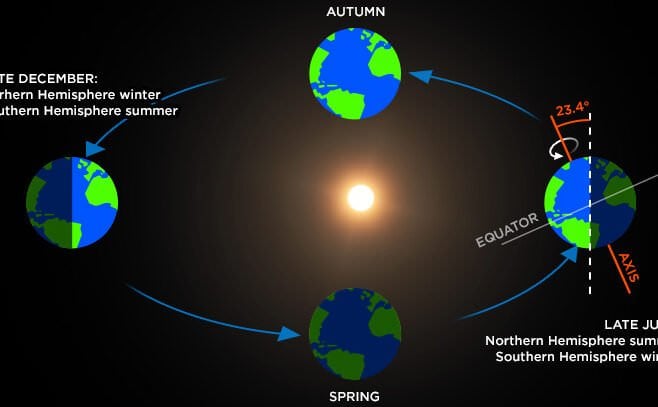Similar to all the celestial bodies in our vast solar system, the Earth undergoes two significant movements – rotation around its axis and revolution around the Sun. The time it takes for one complete rotation of the Earth around its axis is referred to as a day, while the duration it takes to complete its orbit around the Sun is known as a year. This movement is crucial for the existence of life and the adherence to physical laws that govern our planet. Any slight disruption (which has yet to occur) would result in the disturbance of all Earth’s spheres, ecosystems, and living organisms.
Characteristics of Planetary Rotation
The time it takes for the Earth to complete one full revolution around its axis is known as a day, both in common parlance and in scientific terms. A day consists of alternating periods of daylight and darkness, with an average duration of 24 hours. Our planet rotates in a counterclockwise direction, or from west to east. As a result, the inhabitants of the eastern regions are the first to witness the break of dawn, while those in the western hemisphere experience it last. The axis of rotation is an imaginary line that runs through the planet’s North and South Poles. Consequently, these extreme points remain stationary during the rotation process, while all other parts of the Earth are in constant motion.
Due to the west-to-east motion of the planet, we have the opportunity to witness the apparent movement of the entire celestial sphere in the opposite direction, namely, from east to west. This phenomenon applies to both the Sun and the stars that grace our night sky. However, it is worth noting that the Moon deviates from this pattern, as it serves as a satellite of Earth and follows its own unique orbit.
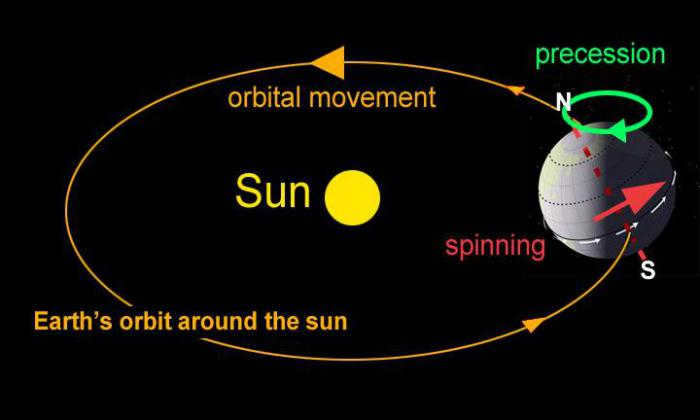
The Earth’s Movement in Figures
The duration of a single rotation of the Earth around its axis is commonly known as a day. Over the course of 24 hours, our planet completes a full revolution, taking into account its unique parameters and mass. As previously mentioned, the Earth’s axis runs from north to south, and during this process, the poles remain stationary, not revolving around it. However, all other regions, including the circumpolar and equatorial zones, move at their own respective speeds. The equatorial zone experiences the highest velocity of rotation, reaching up to 1670 kilometers per hour. Additionally, in this region, the lengths of day and night remain equal throughout the year.
In Italy, the average speed of the Earth’s rotation reaches 1200 km/hour, and this speed changes seasonally, affecting the duration of day and night. As we move closer to the poles, the rotation of the planet slows down, eventually reaching zero.
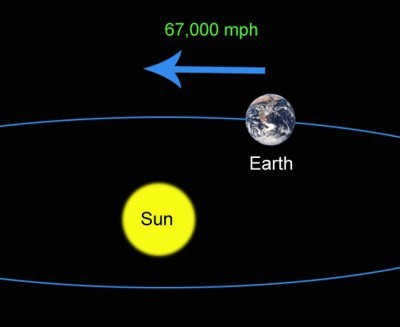

What is the duration of a day and how is it determined?
A day is defined as the time it takes for the Earth to complete one rotation around its axis, and it is conventionally divided into 24 hours. However, it is important to note that there are different types of days, such as the solar day and the sideric day, which have slight but significant differences.
Let’s start by exploring the characteristics of the solar day. Firstly, not every day is exactly 24 hours long. When the Earth is closer to the Sun, its rotation speed increases, causing the day to be slightly shorter. Conversely, when the Earth is farther away from the Sun, its rotation speed slows down, resulting in a slightly longer day. As a result, the duration of a day can vary slightly throughout the year.

Planetary revolution around the Sun constitutes the planet’s second significant rotation.
The Sun is orbited by the Earth in an elliptical path, meaning that its orbit is not a perfect circle but more of an oval shape. The Earth’s velocity as it moves around the Sun has an average of 107,000 kilometers per hour, although this speed can vary. Our planet is typically located about 150 million kilometers away from the Sun. However, the one aspect that remains constant and unchanging is the degree of tilt of the Earth’s axis in relation to its orbit, which is 66 degrees and 33 seconds. This tilt, combined with the shape of the orbit and the variable speed of movement, is what allows us to experience seasonal changes in climate, although not all latitudes are affected in the same way. Near the poles, where daily variations in time and any changes are practically non-existent, seasonal characteristics are also absent. At the equator, the climate remains the same day after day, with consistent weather patterns and equal lengths of day and night throughout the year.
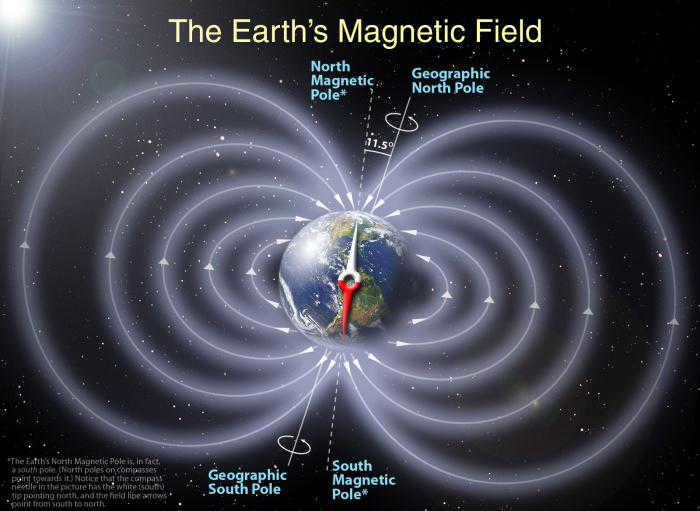
The annual cycle of the ecliptic
The term “ecliptic” refers to the part of the celestial sphere that is located within the orbits of the Earth and the Moon. All the major movements of our planet, as well as the Moon’s orbit around it, occur within this defined circle. It is important to note that the Moon has a significant impact on the Earth’s climate, hydrosphere, and atmosphere. The Moon can cause eclipses, tides, changes in the Earth’s lithosphere, and much more.
Regarding the ecliptic itself, it possesses its own celestial equator, which holds specific astronomical coordinates. In relation to these coordinates, the inclination of all the planets in our solar system is calculated. Similarly, the position of the stars and galaxies that we observe in the heavens is calculated (since their light falls within the ecliptic, making them a part of it). This principle serves as the foundation for astrology. According to this science, the constellations that intersect the ecliptic form the Zodiac. The only exception to this category is the Serpentine. While this constellation is visible in the sky, it is not included in astrological charts.
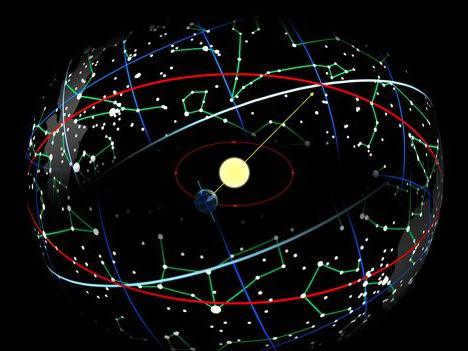

Summary
The length of time it takes for the Earth to complete one rotation around its axis is known as a day. There are two types of days: solar days, which last 24 hours, and sideric days, which last 23 hours and 56 minutes. Day and night occur in all parts of the Earth except for the poles, where the Earth’s rotation speed is zero. The Earth completes one revolution around the Sun in a year, which is 365 days. This annual revolution is responsible for the changing of seasons around the world, except at the equator. The equator experiences the most stable climate, as it rotates around its axis at the fastest speed.

The duration of the Earth’s rotation around its axis remains constant. From an astronomical perspective, it is precisely 23 hours 56 minutes and 4 seconds. However, scientists have disregarded the minuscule discrepancy and rounded these numbers to 24 hours, or one full Earth day. This cycle is referred to as a diurnal rotation and takes place in an eastward direction. To an observer on Earth, it manifests as a sequence of morning, afternoon, and evening following one another. In simpler terms, the occurrence of sunrise, noon, and sunset perfectly aligns with the planet’s daily rotation.
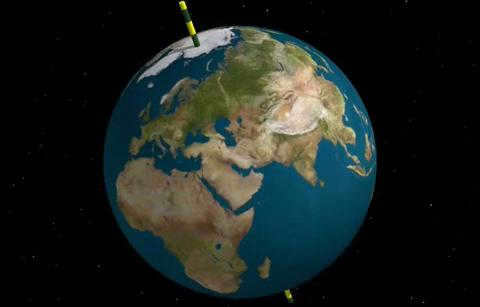
What is the Earth’s axis?
The Earth’s axis is a conceptual line that the third planet from the Sun rotates around. This line intersects the Earth’s surface at two fixed points – the North and South geographic poles. If we imagine extending the Earth’s axis upwards, it would pass near Polaris, which is why Polaris appears stationary. This creates the illusion that the celestial sphere revolves around the axis, and therefore around Polaris.
Even to an observer on Earth, it appears that the starry sky is rotating from east to west. However, this is an illusion. The apparent movement is actually a reflection of the true daily rotation of our planet. It is important to understand that Earth is engaged in not just one, but multiple processes simultaneously. It both rotates on its axis and orbits around the Sun.
The apparent movement of the Sun is a reflection of Earth’s true movement in its orbit around the Sun. As a result, we experience day and night. It is crucial to recognize that these motions are interconnected and cannot exist without each other. These are fundamental laws of the Universe. Furthermore, while Earth’s rotation period on its axis is equal to one Earth day, the time it takes to orbit the Sun is a variable value. Let’s explore the factors that influence these measurements.
What factors influence the Earth’s orbital rotation rate?
The duration of the Earth’s rotation around its axis remains constant, but the speed at which our planet orbits around the sun is not. Astronomers used to believe that this speed was constant, but recent measurements have revealed a slight deviation from previous calculations.
The variability is caused by the friction that occurs during ocean tides. It directly impacts the decrease in the orbital velocity of Earth, the third planet from the Sun. The tides, in turn, are a result of the gravitational influence of Earth’s constant satellite, the Moon. Although humans are unaware of Earth’s rotation around the Moon, as well as its rotation around its own axis, we cannot overlook the changing seasons: spring transitioning to summer, summer to fall, and fall to winter. This perpetual cycle is a consequence of Earth’s orbital motion, which spans 365.25 days, or one Earth year.
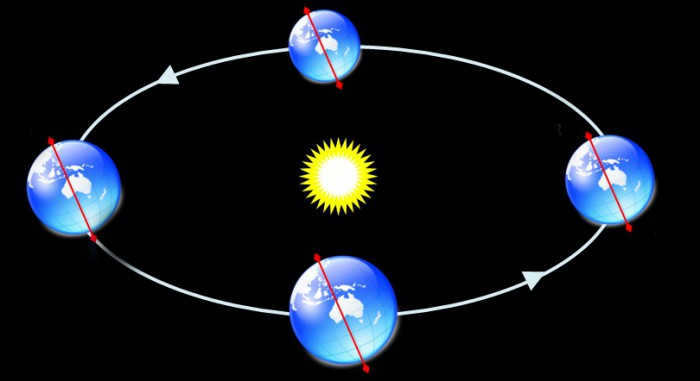
It should be noted that the Earth’s movement in relation to the Sun is not consistent. For instance, there are times when it is nearest to the celestial luminary, while there are other times when it is farthest away. Additionally, it is important to mention that the Earth’s orbit is not a perfect circle, but rather an oval or ellipse.
Why is the rotation of the Earth not noticeable to humans?
It is impossible for a man to perceive the planet’s rotation while standing on its surface. This is due to the vast disparity in size between us and the Earth – it is simply too immense for us to detect! While we may not be aware of the Earth’s rotation period, we can certainly experience its effects: the transition from day to night and vice versa. As previously mentioned, this phenomenon occurs naturally. However, let’s consider a scenario where our blue planet is unable to rotate on its axis. The result would be as follows: one side of the Earth would be stuck in perpetual daylight, while the other side would be shrouded in eternal darkness! Quite dreadful, wouldn’t you agree?


Did you know?
Did you know that the Earth spins around its axis approximately every 24 hours? And did you also know that it takes about 365.25 days for the Earth to complete its journey around the Sun, which we call one Earth year? These values are not fixed and can change over time. It’s fascinating to think about all the different motions that the Earth is involved in. Not only does it rotate and orbit the Sun, but it also moves in relation to the Milky Way, our home galaxy. And even the Milky Way itself is constantly in motion with respect to other neighboring galaxies. The Universe is a dynamic and ever-changing place, and it’s important to remember that nothing remains still or unchanging. Keep this in mind as you navigate through life.
Although the Earth is spherical, it is not a perfect sphere. Due to its rotation, the planet is slightly flattened at the poles, resulting in a shape known as a spheroid or geoid – resembling the Earth.
The Earth is incredibly vast, making it difficult to comprehend its size. The key parameters of our planet are as follows:
- Diameter – 12,570 km
- Equator length – 40,076 km
- Meridian length – 40,008 km
- Total surface area of the Earth – 510 million km2
- Polar radius – 6,357 km
- Equatorial radius – 6,378 km
The Earth rotates both around the sun and its own axis simultaneously.
The Earth revolves around an inclined axis in a westerly to easterly direction. One side of the planet is lit up by the sun, creating daytime, while the other side is cast in shadow, resulting in nighttime. The rotation of the Earth is responsible for the alternating cycles of day and night. It takes the Earth 24 hours, or one day, to complete one full rotation on its axis.
As a result of this rotation, there is a deflection in the movement of streams such as rivers and winds in the northern hemisphere, causing them to veer to the right. Conversely, in the southern hemisphere, these streams deviate to the left.
The Earth orbits around the Sun in a circular path, completing one full revolution in a year. The axis of the Earth is not perpendicular to the orbit, but inclined at an angle of 66.5°. This angle remains constant throughout the entire rotation. This rotation is responsible for the changing of seasons.
Let’s examine the points at which the Earth’s rotation around the Sun reaches its extremes.
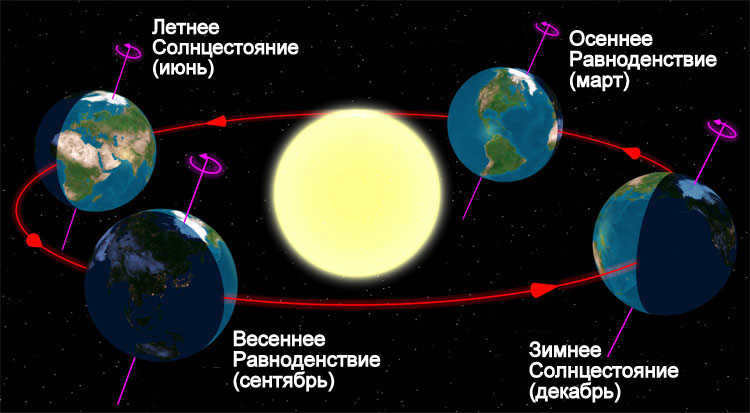
- December 22 marks the winter solstice, when the sun is closest to the zenith in the southern tropic. This means that it is summer in the southern hemisphere and winter in the northern hemisphere. In the southern hemisphere, the nights are short, and at the southern polar circle, there is no night on December 22 as the day lasts for 24 hours. In contrast, in the northern hemisphere, the night lasts for 24 hours at the northern polar circle.
- June 22 is known as the summer solstice, when the sun is closest to the northern tropic. This results in summer in the northern hemisphere and winter in the southern hemisphere. On June 22, the night lasts for 24 hours at the southern polar circle, while at the northern polar circle, there is no night at all.
- March 21, September 23 – the dates when the spring and fall equinoxes occur. These are the days when the sun is closest to the equator, resulting in equal day and night in both the northern and southern hemispheres.
Throughout history, humans have been intrigued by the changing of day and night, the transition from winter to spring, and summer to fall. As our understanding of the world grew, scientists began to study the Earth more closely, seeking to determine the speed at which it orbits the sun and rotates on its axis.
The Earth’s Movement
All celestial objects are in constant motion, including the Earth. It undergoes both axial rotation and orbital motion around the Sun.
To understand the Earth’s movement visually, imagine a spinning top rotating on its own axis while moving swiftly across the floor. Without this motion, our planet would not be suitable for life. Without its rotation, one side of the Earth would constantly face the Sun, resulting in extreme temperatures of +100 degrees and the evaporation of all water in that region. On the other side, temperatures would be constantly freezing, causing the surface to be covered in ice.
Rotational Path
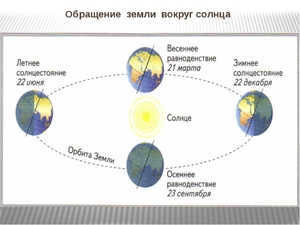
The Earth’s path around the Sun is determined by the Sun’s gravitational pull and our planet’s velocity, creating an orbit. If the gravitational force were increased or the velocity decreased, the Earth would be pulled towards the Sun. However, if the gravitational force ceased to exist or significantly weakened, the planet would be propelled away from the Sun due to its centrifugal force. This would be similar to spinning an object attached to a rope above your head and suddenly letting go.
The Earth’s path around the sun is not a perfect circle, but rather an elliptical shape. This means that the distance between the Earth and the sun varies throughout the year. In the month of January, the Earth reaches its closest point to the sun, known as perihelion, and is approximately 147 million kilometers away. On the other hand, in July, the Earth is at its farthest point from the sun, known as aphelion, and is approximately 152 million kilometers away. On average, the distance between the Earth and the sun is about 150 million kilometers.
As the Earth travels around the sun, it moves in a counterclockwise direction. This means that it moves from west to east in its orbit.
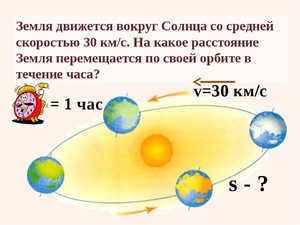
The Earth completes one revolution around the center of the solar system in 365 days, 5 hours 48 minutes 46 seconds (equivalent to 1 astronomical year). However, for convenience, a calendar year is considered to have 365 days, and the remaining time is “accumulated” and adds one day to each leap year.
The Earth’s orbital distance is 942 million kilometers. According to calculations, the Earth’s speed is 30 kilometers per second or 107,000 kilometers per hour. Although this speed is imperceptible to humans, as everything moves together in the coordinate system, it is actually quite significant. To put it into perspective, the highest speed of a racing car is 300 kilometers per hour, which is 365 times slower than the speed at which the Earth travels in its orbit.
Nevertheless, the velocity of 30 km/s is not consistent because the orbit takes the form of an ellipse. The velocity of our celestial body fluctuates slightly throughout its journey. The most significant variation occurs when the celestial body reaches the perihelion and aphelion points, amounting to 1 km/s. In other words, the average speed of 30 km/s is an approximation.
Axial rotation
The Earth’s axis is an imaginary line that runs from the north pole to the south pole. It is tilted at an angle of 66°33′ relative to the plane of our planet. The Earth completes one revolution on its axis in a period of 23 hours, 56 minutes, and 4 seconds, which is known as a sidereal day.
One of the main effects of axial rotation is the alternation of day and night on Earth. Additionally, this motion results in:
- The Earth having a slightly flattened shape at its poles;
- The displacement of objects (such as river currents and wind) that move in a horizontal plane (to the left in the Southern Hemisphere and to the right in the Northern Hemisphere).
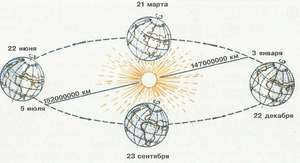
The speed of axial motion varies significantly across different regions. The highest velocity, known as linear velocity, is 465 m/s or 1674 km/h at the equator. This speed can be observed, for instance, in the capital of Ecuador. As one moves north or south of the equator, the rotational speed decreases. In Moscow, for example, it is nearly half of the equatorial speed. These velocities are referred to as angular velocities and their magnitude decreases as one approaches the poles. At the poles themselves, the velocity is zero, meaning that they are the only parts of the planet that do not experience any movement in relation to the axis.
The change of seasons is determined by the location of the axis at a certain angle. Different areas of the planet receive varying amounts of heat at different times due to this position. If our planet were vertically aligned with the Sun, there would be no seasons because both the northern and southern latitudes would receive the same amount of heat and light during the daytime.
There are several factors that affect axial rotation:
- Seasonal changes, including precipitation and atmospheric movement.
- Tidal waves that oppose the direction of axial motion.
These factors cause the planet to slow down, leading to a decrease in its velocity. The rate of this decrease is very small, only 1 second in 40,000 years. However, over 1 billion years, the length of a day has increased from 17 to 24 hours.
Scientists continue to study the Earth’s movement to this day. These findings are crucial for creating more accurate star charts and understanding how this motion affects natural processes on our planet.
Similar to the other planets in our vast solar system, the Earth undergoes two significant revolutions – one around its axis and another around the Sun. The duration of one complete rotation of the Earth on its axis is referred to as a day, while the time it takes to complete one orbit around the Sun is known as a year. This movement is fundamental to the existence of life and the physical laws that govern our planet. Any disruption (which has yet to occur) would have severe consequences for the Earth’s various spheres, ecosystems, and living organisms.
Characteristics of Planetary Rotation
Within both popular culture and scientific understanding, the period of one complete revolution of the Earth around its axis is referred to as a day. Days consist of alternating periods of light and darkness, which, on average, total 24 hours. Our planet rotates in a counterclockwise direction, or from west to east. As a result, residents of eastern regions are the first to witness the dawn, while those in the western hemisphere experience it last. The axis of rotation is an imaginary line that passes through the Earth’s North and South poles. Consequently, these extreme points do not actively participate in the rotational movement, while all other areas of the planet are in motion.
As the planet moves in an eastward direction, we can witness the entire celestial sphere appearing to move in the opposite direction, specifically from west to east. This phenomenon is true for the Sun and all the stars we observe, with the exception of the Moon. Being a satellite of Earth, the Moon follows its own unique orbit.
It is the diurnal period that determines the rate of rotation around the axis. Within a span of 24 hours, a celestial body must complete a full revolution, taking into account its unique parameters and mass. As previously mentioned, the axis of the Earth runs from north to south, with the poles remaining stationary during this process. However, all other regions, including the circumpolar and equatorial zones, experience movement at varying speeds. The equator boasts the highest rotation speed, clocking in at 1670 kilometers per hour. Additionally, this region experiences an equal number of daylight and nighttime hours throughout the year.
In Italy, the average speed of rotation for the Earth is 1200 kilometers per hour, with the duration of day and night changing seasonally. Consequently, as we approach the poles, the planet gradually slows its rotation, eventually reaching zero.
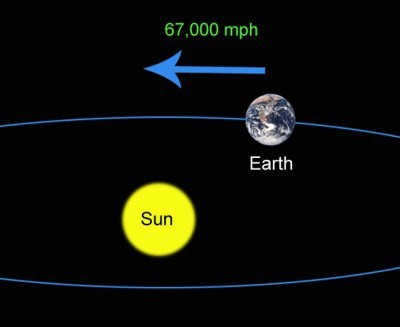
How are days calculated and what do they mean?
A day is defined as the time it takes for the Earth to complete one revolution around its axis, and it is conventionally divided into exactly 24 hours. However, it is important to note that there are different types of days, such as solar day and sideric day, which have a slight but significant difference in duration.
Let’s start by examining the characteristics of the solar day. Firstly, not every day lasts exactly 24 hours. When the Earth is closer to the Sun, its rotation speed around its axis increases, while it slows down when it is farther away from the Sun. As a result, the length of a day can vary slightly, with summer days being slightly shorter and winter days being slightly longer.
Regarding the sideric days, they last for 23 hours, 56 minutes, and 4 seconds. This is the amount of time it takes for our planet to complete one rotation on its axis in relation to a distant star. In other words, if that distant star happened to be the Sun, then the entire 360-degree rotation would be completed within this timeframe. However, in order to complete a full rotation in relation to the Sun itself, an additional degree must be traversed, which takes just four minutes.

Planet’s second primary revolution occurs in orbit around the Sun
The Earth revolves around the Sun in an elliptical path. This means that its orbit is not a perfect circle, but rather an oval shape. The average speed of the Earth’s movement around the Sun is approximately 107,000 kilometers per hour, although this speed is not constant. The average distance between our planet and the Sun is about 150 million kilometers. The one aspect that remains constant is the tilt of the Earth’s axis relative to its orbit, which is 66 degrees and 33 seconds, regardless of the time of day or year. It is this tilt, combined with the shape of the orbit and the varying speed of movement, that allows us to experience seasonal changes in climate, although not all latitudes are affected. In regions near the poles, where daily variations are minimal, seasonal changes are also minimal. Similarly, at the equator, seasonal variations are almost non-existent. Each day here is nearly identical to the previous day, with the same weather and equal lengths of day and night.
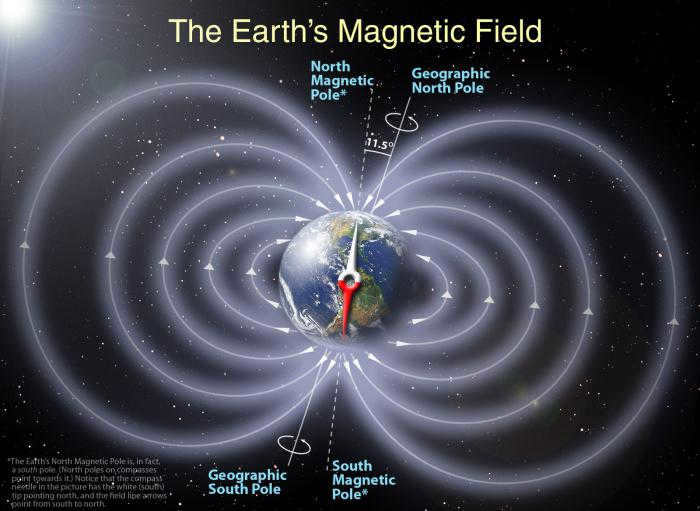
The orbit and its yearly revolution
The term “orbit” refers to the path that the Earth and the Moon travel along in space. Within the boundaries of this traditional path, all of our planet’s major movements take place, including the Moon’s rotation around it. It is important to note that the Moon’s rotation has a significant impact on the climate, hydrosphere, and can even cause eclipses, changes in the Earth’s crust, and more.
Speaking of the ecliptic itself, this plane is associated with its celestial equator, which possesses specific astronomical coordinates. In relation to these coordinates, the inclination of all the planets within the solar system is calculated. Likewise, the positioning of stars and galaxies that are observed in the sky is calculated (as their light enters the ecliptic, making them a part of it). This theory serves as the foundation of astrology. According to this science, the constellations that intersect with the ecliptic form the Zodiac. The only constellation that does not fall into this category is the Serpent. While visible in the sky, it does not appear in astrological tables.
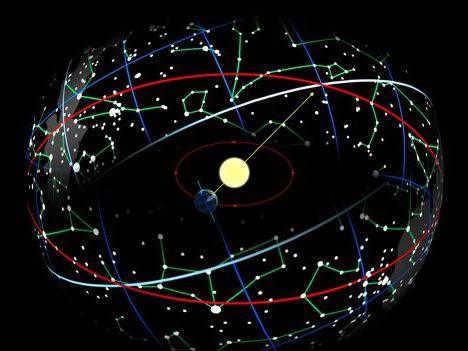
Summarizing
A day is the period of time it takes for the Earth to complete one rotation around its axis. There are two types of days: solar days, which last 24 hours, and sideric days, which last 23 hours and 56 minutes. Day and night occur in all latitudes of the Earth, except for the poles where the Earth’s rotation speed is zero. The Earth completes one revolution around the Sun in a year, which is 365 days. During this time, the seasons change in all parts of the Earth except for the equator, which remains relatively stable as it rotates around its axis.
Motion around an axis of rotation is a common form of movement observed in nature. In this article, we will explore this type of motion from both a dynamic and kinematic perspective, while also providing formulas that relate to fundamental physical quantities.
What Type of Motion Are We Discussing?
Specifically, we will be discussing the circular movement of objects, which involves their rotation. Examples of such motion can be seen in the spinning wheels of cars or bicycles while in motion. Additionally, the intricate pirouettes performed by figure skaters on ice involve rotation around their axis. Lastly, we will also examine the rotation of our planet around the Sun, as well as its own axis, which is inclined to the ecliptic plane.
It is evident that the axis of rotation is a crucial component in the motion being discussed. Every point on a body of any shape undergoes circular motions around this axis. The distance from each point to the axis is referred to as the radius of rotation. Various characteristics of the entire mechanical system, such as moment of inertia and linear velocity, rely on this value.
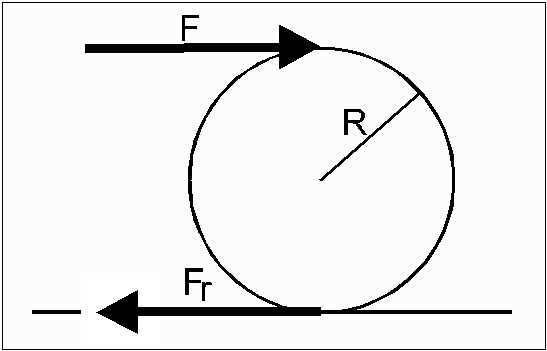
If the reason for the linear translational movement of objects in space is an external force acting on them, then the reason for the movement around the axis of rotation is an external moment of force. This measurement is defined as the cross product of the applied force F¯ and the vector of the distance from its point of application to the axis r¯, i.e., r¯:
The effect of the momentum M¯ results in the angular acceleration α¯ in the system. Both measurements are connected to each other by a coefficient I through the following equation:
The value I is known as the moment of inertia. It is dependent on the shape of the object, the distribution of mass within it, and the distance to the axis of rotation. For a material point, it can be calculated using the formula:
If the net external force acting on the system is zero, then the system will maintain its linear momentum L¯. This is a vector quantity that is defined as:
Here p¯ represents the linear momentum.
The principle of conservation of linear momentum L¯ is often expressed in the following manner:
Where ω denotes the angular velocity. Further discussion on this topic will be provided in the article.
Rotational Kinematics
Unlike dynamics, this section of physics focuses solely on important practical quantities related to the change in position of objects in space over time. In other words, rotational kinematics deals with the study of velocities, accelerations, and angles of rotation.
Let’s start by introducing angular velocity. It refers to the angle that a body rotates through in a given unit of time. The formula for instantaneous angular velocity is as follows:
If a body rotates through equal angles in equal time intervals, the rotation is called uniform. The formula for average angular velocity in this case is:
Angular velocity (ω) is measured in radians per second, which corresponds to inverse seconds (s-1) in the SI system.
When dealing with non-uniform rotation, we introduce the concept of angular acceleration α. This represents the rate at which the angular velocity ω changes over time:
Angular acceleration α is typically measured in radians per second squared (in SI units – s -2).
If an object initially rotates uniformly with an angular velocity ω 0 and then starts to accelerate with a constant angular acceleration α, we can describe its motion using the following equation:
This equation is derived by integrating the equations of angular velocity over time. The equation for θ allows us to calculate the number of revolutions the system will complete around the axis of rotation in a given time t.
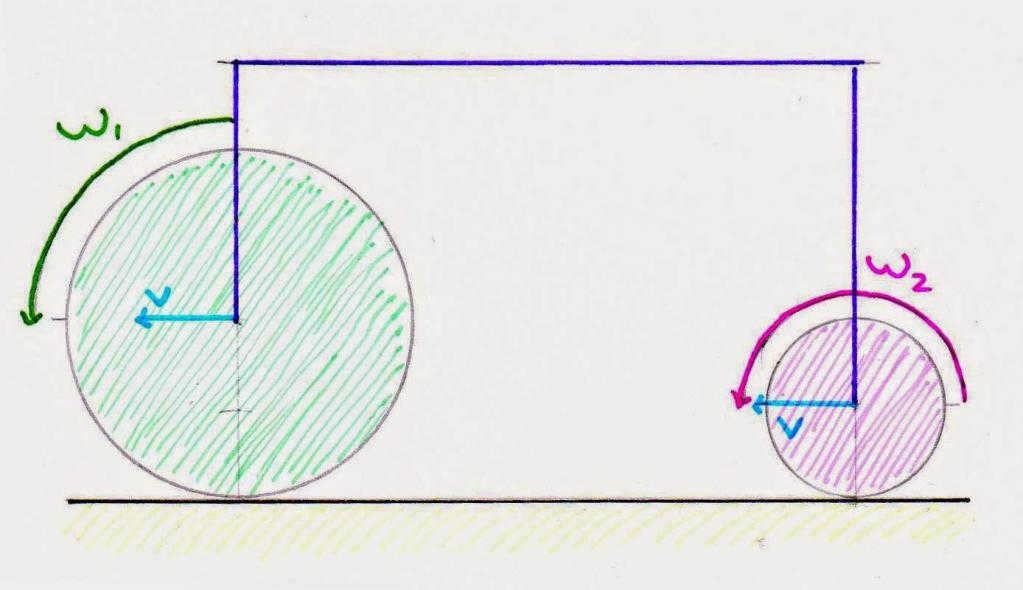
Both velocities are interconnected. When discussing the rotational velocity around an axis, both linear and angular characteristics may come to mind.
Let’s say that a certain material point is rotating about an axis at a distance r with a velocity ω. In this case, its linear velocity v will be equal to:
The distinction between linear and angular velocity is significant. Therefore, ω remains constant during uniform rotation regardless of the distance to the axis, whereas the value of v increases linearly as r increases. This explains why it becomes more challenging to keep a body on a circular trajectory as the radius of rotation grows (its linear velocity and, consequently, inertial forces increase).
The challenge of determining the Earth’s axis rotation speed
It is a well-known fact that our planet, Earth, undergoes two distinct types of rotational movements as it orbits the Sun:
Now, we will perform calculations to determine the velocities, ω and v, associated with the first type of rotational motion.
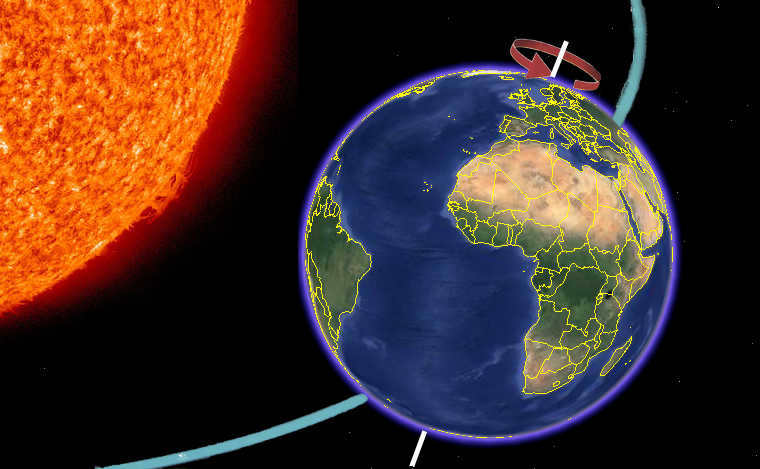
Determining the angular velocity is a straightforward task. To do so, let us recall that the Earth completes a full revolution of 2*pi radians in 24 hours (or precisely 23 hours 56 minutes 4.1 seconds). Thus, the value of ω can be calculated as follows:
The computed value is relatively small. Now, let’s compare the absolute value of ω with that of v.
Next, let’s calculate the linear velocity v for points located on the Earth’s surface at the equator. Since the Earth is an oblate spheroid, its equatorial radius is slightly larger than the polar radius, measuring 6378 km. By utilizing the formula for the relationship between two velocities, we can determine the following:
The resulting speed amounts to 1670 km/h, which surpasses the speed of sound in air (1235 km/h).
The Earth’s rotation around its axis gives rise to the well-known Coriolis force, which must be taken into consideration in the trajectory of ballistic missiles. It is also responsible for various atmospheric phenomena, such as the deflection of trade winds towards the west.
For an observer situated in the Northern Hemisphere, such as in the European part of Russia, the Sun consistently appears in the east and moves towards the south, reaching its highest point in the sky at noon, before descending towards the west and eventually setting below the horizon. This apparent motion of the Sun is solely due to the Earth’s rotation on its axis. When observed from above in the direction of the North Pole, the Earth rotates counterclockwise. In this scenario, the Sun remains stationary, with the perception of its movement being a result of the Earth’s rotation.
Earth’s yearly revolution
The Earth also revolves counterclockwise around the Sun, while rotating on its own axis. If viewed from above, from the North Pole, the planet appears to rotate counterclockwise. Due to the tilt of the Earth’s axis in relation to its orbit, different regions receive varying amounts of sunlight as the Earth revolves around the Sun. This uneven illumination results in the changing of seasons and the length of the day.
Twice a year, on March 21 and September 23, the Sun shines with equal brightness on both the Northern and Southern Hemispheres. These specific instances are also referred to as the autumnal equinox. In March, it signals the onset of autumn in the Northern Hemisphere and the commencement of spring in the Southern Hemisphere. Conversely, in September, it signifies the arrival of fall in the Northern Hemisphere and the advent of spring in the Southern Hemisphere.
Summer and winter solstice
On June 22nd in the Northern Hemisphere, the Sun reaches its highest point above the horizon. This day has the longest duration of daylight and the shortest night. Conversely, on December 22nd, the winter solstice takes place, marking the shortest duration of daylight and the longest night. In the Southern Hemisphere, the situation is reversed.
Polar night
Because of the Earth’s axis tilt, the polar and circumpolar areas in the Northern Hemisphere experience a period of darkness during the winter months, where the Sun remains below the horizon throughout the day. This natural occurrence is called the polar night. The Southern Hemisphere also experiences a polar night in its circumpolar regions, but the timing is opposite, occurring six months apart.
What Causes the Earth to Rotate Around the Sun
Planets are naturally inclined to orbit around their stars to prevent them from being pulled in and consumed. The Earth, however, has a distinct characteristic that has allowed for the evolution of a wide range of life forms on the planet – its axial tilt of 23.44o.
The axial tilt is responsible for the changing seasons and the creation of different climate zones, which in turn have fostered the development of diverse flora and fauna on Earth. This tilt also influences the heating of the Earth’s surface, leading to the movement of air masses and the formation of precipitation in the form of rain and snow.
The orbit of the Earth around the Sun is a path that the Earth follows as it revolves around the Sun. The shape of this path is an ellipse, and on average, the Earth is located about 150 million kilometers away from the Sun. At its farthest point, called aphelion, the Earth is about 152 million kilometers away from the Sun, and at its closest point, called perihelion, it is about 147 million kilometers away.
As the Earth orbits the Sun, it moves from west to east at an average speed of 108 km/h. It takes the Earth about 365 days, 6 hours, 9 minutes, and 9 seconds to complete one full revolution around the Sun, which is also known as a sidereal year. During this time, the Earth travels a distance of approximately 940 million kilometers.
The Earth’s movement in its orbit and the angle at which its axis is tilted relative to the plane of the solar system have a direct impact on the changing of seasons and the variation in the length of day and night.
Characteristics of the Earth’s orbit around the Sun
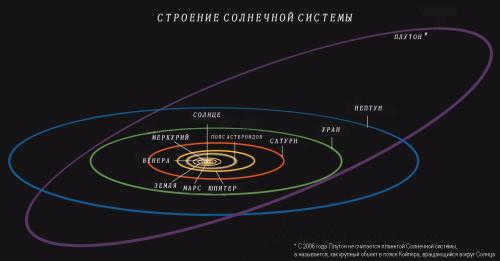
In ancient times, astronomers held the belief that the Earth occupied the central position in the universe and that all celestial bodies revolved around it. This theory, known as geocentrism, was later disproven by the Polish astronomer Nicolaus Copernicus in 1534. Copernicus introduced the heliocentric model, which demonstrated that the Sun is the center of our solar system and that the Earth, along with other planets, orbits around it. Despite the opposition from Ptolemy, Aristotle, and their followers, Copernicus’s heliocentric model prevailed.
The Earth follows an elliptical path, known as an orbit, as it revolves around the Sun. The length of this orbit is approximately 940 million kilometers. It takes the Earth 365 days, 6 hours, 9 minutes, and 9 seconds to complete one full revolution around the Sun. To account for the extra six hours that accumulate over four years, an additional day is added to the calendar, resulting in a leap year with 366 days. This extra day falls on February 29th.
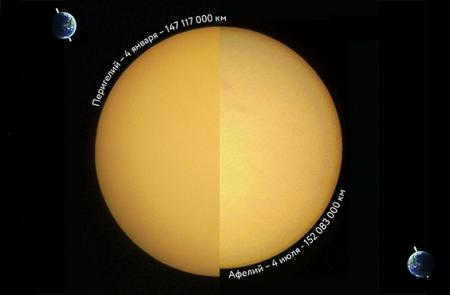
Throughout its orbit, the Earth experiences two extreme points in its distance from the Sun. The first point, known as aphelion or apogelion, occurs on July 3 and is when the Earth is farthest from the Sun, reaching a distance of 152 million kilometers. The second point, called perihelion, takes place on January 3 and is when the Earth is closest to the Sun, reaching a distance of 147 million kilometers.
Due to the Earth’s axial tilt of 66.5 degrees in relation to the plane of its orbit around the Sun, the Earth’s surface receives varying amounts of heat and light during its movement. This variation in sunlight is the main cause of the changing seasons and the differences in day and night duration. However, at the equator, both day and night are always equal in length, lasting 12 hours each.
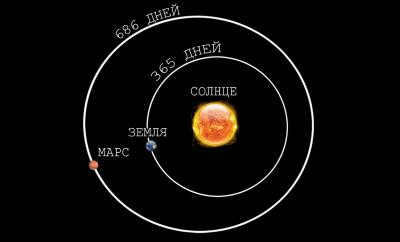
(The Earth completes one revolution around the Sun in 365 days, 6 hours, 9 minutes, and 9 seconds)
Velocity of Earth’s orbit around the Sun
The average velocity of the Earth orbiting the Sun is 30 km/s or 108,000 km/h (which is 1/10,000th of the speed of light). To put it into perspective, the diameter of our planet is 12,700 km, and at this velocity, you could traverse that distance in just 7 minutes. Additionally, you could travel from the Earth to the Moon (384,000 km) in four hours. During aphelion, when the Earth is farthest from the Sun, its velocity slows down to 29.3 km/s, while during perihelion, when it is closest to the Sun, it accelerates to 30.3 km/s.
The impact of the Earth’s orbit around the Sun on the seasonal variations
The inclination of the Earth’s axis with respect to the elliptical plane is 66.3 0 , and it remains constant throughout its orbit. The angle between the ecliptic plane, in which the Earth moves around the Sun, and its axis of rotation is 26 0 26 ꞌ .
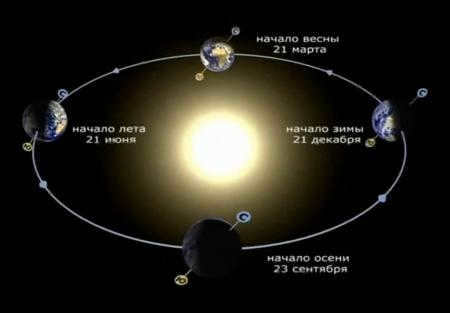
(The Earth’s rotation period)
The intersections between the celestial equator and the ecliptic are marked by the vernal equinox (March 21) and the fall equinox (September 23). On these days, the length of day and night are equal, and the Sun’s rays illuminate and warm both hemispheres evenly. The angle at which the Sun’s rays fall on the equator line is 90 degrees. Spring and fall are considered to begin astronomically in the respective hemispheres based on the dates of the vernal and autumnal equinoxes.
On December 22, the duration of the day is longer in the Southern Hemisphere up to the 66.5 parallel, while in the Northern Hemisphere it is shorter. This date marks the beginning of winter in the Northern Hemisphere and the start of summer in the Southern Hemisphere.
Theme “Earth is a planet of the Solar System”
1. In 4 hours, the Earth completes one full rotation on its axis.
2. In 1 hour, the Earth completes a partial rotation on its axis.
3. The Earth’s rotation on its axis is responsible for:
2) the change between day and night
3) the change of seasons
4. The Earth’s orbit around the Sun is responsible for:
1) The continents and oceans on the Earth’s surface contribute to the presence of continents and oceans on the Earth’s surface.
2) Day and night change due to Earth’s rotation around its axis.
3) The change of seasons occurs as a result of Earth’s motion around the Sun.
4) The Age of Discovery began with the exploration of new lands.
5. What is the cause of the change of day and night on Earth?
1) The presence of continents and oceans on the Earth’s surface.
2) Earth’s motion around its axis.
3) Earth’s motion around the Sun.
4) The movement of the Moon around the Earth.
6. On which dates on Earth are the lengths of day and night equal?
7. On which date will the day be the longest?
8. Which statement about the Earth’s motion is true?
1) The Earth’s rotation around the Sun causes the alternation of day and night.
2) The Earth’s axial motion results in the change of seasons.
3) The alternation of day and night is a result of the Earth’s rotation on its axis.
4) During winter, the Earth rotates on its axis, while during summer, it revolves around the Sun.
9. Which of the following statements about the Earth’s motion is true?
1) The change of seasons occurs due to the Earth’s rotation on its axis.
2) The change of seasons occurs because of the Earth’s revolution around the Sun.
3) The alternation of day and night is a result of the Earth’s rotation around the Sun.
4) During summer, the Earth rotates on its axis, while during winter, it revolves around the Sun.
The Earth is in continuous motion as it orbits around the Sun and rotates on its own axis. The Earth’s axis, which extends from the North Pole to the South Pole, remains fixed while rotating at an angle of 66 0 33′ to the Earth’s plane. The rotation of the Earth is not perceptible to people because all objects move in parallel with the same speed. It would appear as if we were on a ship, unaware of the movement of objects and things on board.
A full rotation around the axis is completed in a single stellar day, which lasts for 23 hours, 56 minutes, and 4 seconds. During this time, one side of the planet faces the Sun, receiving varying amounts of heat and light. Furthermore, the Earth’s rotation affects its shape, causing the poles to flatten. This rotation also causes a deviation in the movement of objects in the horizontal plane. In the Southern Hemisphere, rivers, currents, and winds are deflected to the left, while in the Northern Hemisphere, they are deflected to the right.
Linear and angular rotation velocity
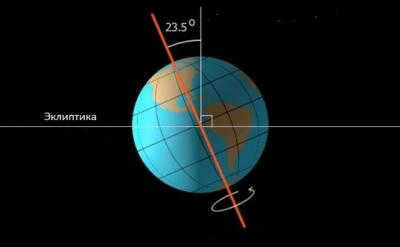
The Earth’s rotation around its axis has a linear speed of 465 m/s or 1674 km/h at the equator. As you move away from the equator, the speed gradually decreases, eventually reaching zero at the North and South Poles. For instance, residents of Quito, the capital of Ecuador in South America, experience a rotational speed of 465 m/s, while those living in Moscow, located on the 55th parallel north of the equator, have a speed of 260 m/s (almost half of the equatorial speed).
Every year, the Earth’s rotation speed decreases by 4 milliseconds due to the effect of the Moon on the strength of the tides in the sea and oceans. The gravitational pull of the Moon causes water to move in the opposite direction of the Earth’s axial rotation, resulting in a small amount of friction that slows down the rotation by 4 milliseconds. The angular velocity of rotation remains constant at 15 degrees per hour.
Reasons behind the transition from day to night
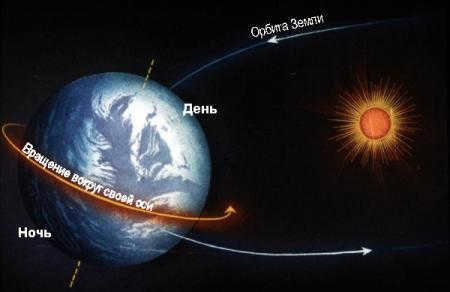
The Earth completes one full rotation around its axis in a sidereal day, which is equivalent to 23 hours, 56 minutes, and 4 seconds. During this period, one side of the Earth is illuminated by the Sun, experiencing daylight, while the other side is in the shadow, experiencing nighttime. This cycle then reverses.
If the Earth had a different rotation pattern, with one side always facing the Sun, extreme temperatures of up to 100 degrees Celsius would occur, causing all water to evaporate. Conversely, on the opposite side, freezing temperatures would prevail, with water trapped under a thick layer of ice. Both of these scenarios would be inhospitable for the development of life and the survival of the human species.
What causes the change of seasons

(The Earth’s rotation and its impact on the changing of the seasons)
If the Earth were positioned vertically in relation to the Sun, the existence of seasons would be eliminated entirely. This is because every point on the hemisphere facing the Sun would receive an equal amount of heat and light.
The topic that is considered the most challenging in not only the 5th grade but also in all of geography has sneaked up on me and my fifth-graders without notice. It is no secret that children often make mistakes in the USE questions regarding the movements of the Earth and the angle at which the sun’s rays hit the Earth. And it’s not surprising! In the past (a few years ago when I was using the textbook by Gerasimova and Neklyukova), this topic was taught at the end of the 3rd quarter of the 6th grade and still caused a lot of difficulties for the students. But now, it is being taught at the beginning of the second quarter of the 5th grade! It’s quite a change, isn’t it?
So, the topic we will be studying is “Earth’s Movements. Sunlight on Earth.“.
However, the topic that we have thoroughly explored (I can only hope for now, but only time will reveal the true success) involved the utilization of a tellurium (a miniature representation of the solar system that demonstrates the Earth’s rotation on its axis and around the Sun, along with the Moon’s rotation around the Earth). We supplemented our study with the aid of maps and illustrations from the textbook and atlas, as well as the preexisting knowledge possessed by the students.
The lessons for the fifth graders did not conclude with the sound of the bell – everyone was eager to interact with and manipulate the tellurium!

Today we have obtained definite evidence that:
— The Moon orbits around the Earth.
— The Earth rotates around itself and orbits around the Sun.
— The Earth’s axial tilt is the primary cause of the changing seasons.
— The Earth’s year consists of one revolution around the Sun, but it is not exactly 365 days long!
— A day is not precisely 24 hours!
and much, much more.
I cordially invite you, esteemed guests and readers, to take a moment to recollect and contemplate the Earth’s motion, the reasons behind the changing seasons, and how the Earth’s movement influences its climate.
From a human perspective, the Earth is an immense entity, weighing a staggering 6,000,000,000,000,000,000,000,000,000,000,000,000 tons! As a result, it is difficult for inhabitants of Earth to fathom that this colossal mass is in perpetual motion. The two primary forms of Earth’s motion, recognized by humanity since ancient times, consist of its rotation on its axis and its orbit around the Sun.
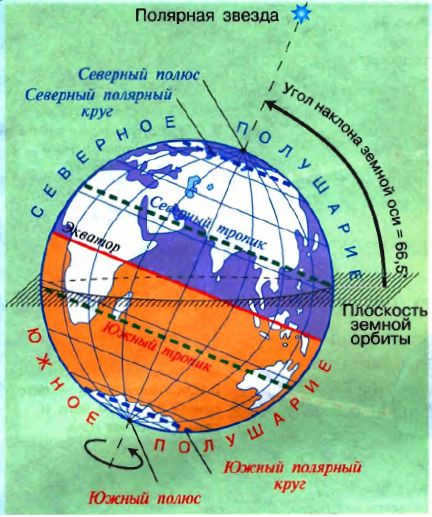
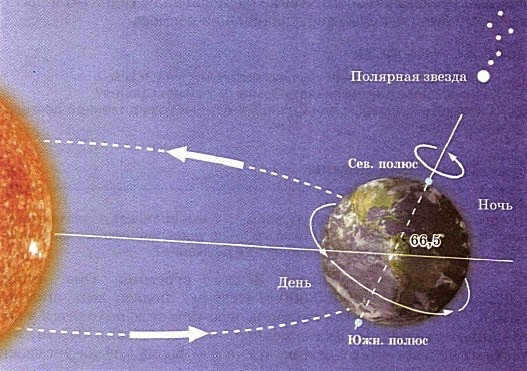
The impact of the Earth’s rotation on its axis on geography:
— The shape of the Earth is influenced by its rotation, resulting in a slight flattening at the poles.
— The Earth’s rotation causes a deflection to the right in the Northern Hemisphere and to the left in the Southern Hemisphere for all objects moving on its surface.
— Day and night cycles are caused by the rotation of the Earth.
— If the Earth’s axis was not properly aligned in space, the Earth would undergo unpredictable tumbling motions.
If the rotation of the Earth on its axis and its orbit around the Sun were to cease, there would be a perpetual day on one side of the Earth, with temperatures soaring to 100°C or more, resulting in the evaporation of all water. On the opposite side, darkness would prevail, creating an eternal realm of icy coldness, where the Earth’s moisture would accumulate in the form of a colossal ice cap.
The Earth’s orbit around the Sun
The Earth travels around the Sun at a velocity of 30 kilometers per second. Its distance from the Sun is nearly 150 million kilometers. This vast distance, significant for the existence of life, is inconsequential in the realm of space.
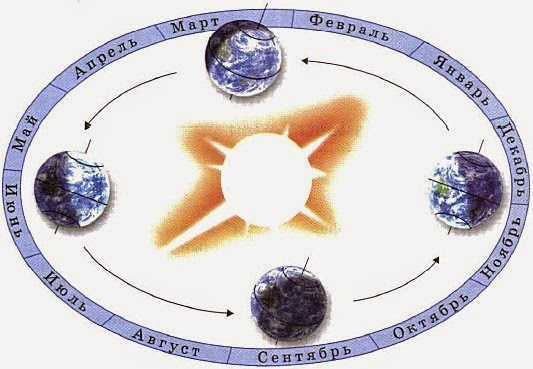
For convenience, the duration of one year is defined as 365 days. The extra 6 hours are accumulated and every four years they add up to form an extra day. These particular years are known as leap years and they consist of 366 days instead of the usual 365. In leap years, the shortest month – February – has 29 days instead of the usual 28.
Imagine if it were true.
If the Sun suddenly ceased to exert its gravitational pull on the Earth, our planet would hurtle into space at a speed 40 times faster than a speeding bullet!
If the Earth’s orbit was slower, it would be powerless against the Sun’s gravitational force and would ultimately succumb to its pull.
If the Earth were positioned closer to the Sun, its temperature would skyrocket. Take Venus, for example, which is located 42 million kilometers closer to the Sun and boasts an average temperature of about 500°C!
On the other hand, if the Earth were farther away from the Sun, it would experience frigid temperatures. Look at Mars, which is situated 228 million kilometers away from the Sun and has a surface temperature of -60°C.
It takes the Earth 365 days and 6 hours to complete a full revolution around the Sun, a period commonly referred to as a year .
The Earth spins on its axis in a westward to eastward direction, while simultaneously revolving around the Sun in the same westward to eastward direction.
Due to the spherical shape of the Earth, the amount of sunlight and heat received at the equator is greater than that at the polar regions. This is the reason why the equator is hot while the poles are cold. If the Earth’s surface were flat, the sunlight would be evenly distributed, resulting in equal heating. The highest point of the Sun above the horizon is called the zenith. When the Sun is at the zenith, its rays fall directly to the Earth.
Tropics – The tropics are imaginary lines that mark the area on both sides of the equator where the Sun is directly overhead.
Polar circles – The polar circles are imaginary lines that mark the areas around the poles where there are periods of continuous daylight and continuous darkness.
The tropics and polar circles divide the Earth’s surface into different belts that have varying durations of sunlight and amounts of heat received from the Sun. Depending on the angle of the Sun’s rays and the length of daylight hours, five different illuminance belts can be distinguished.
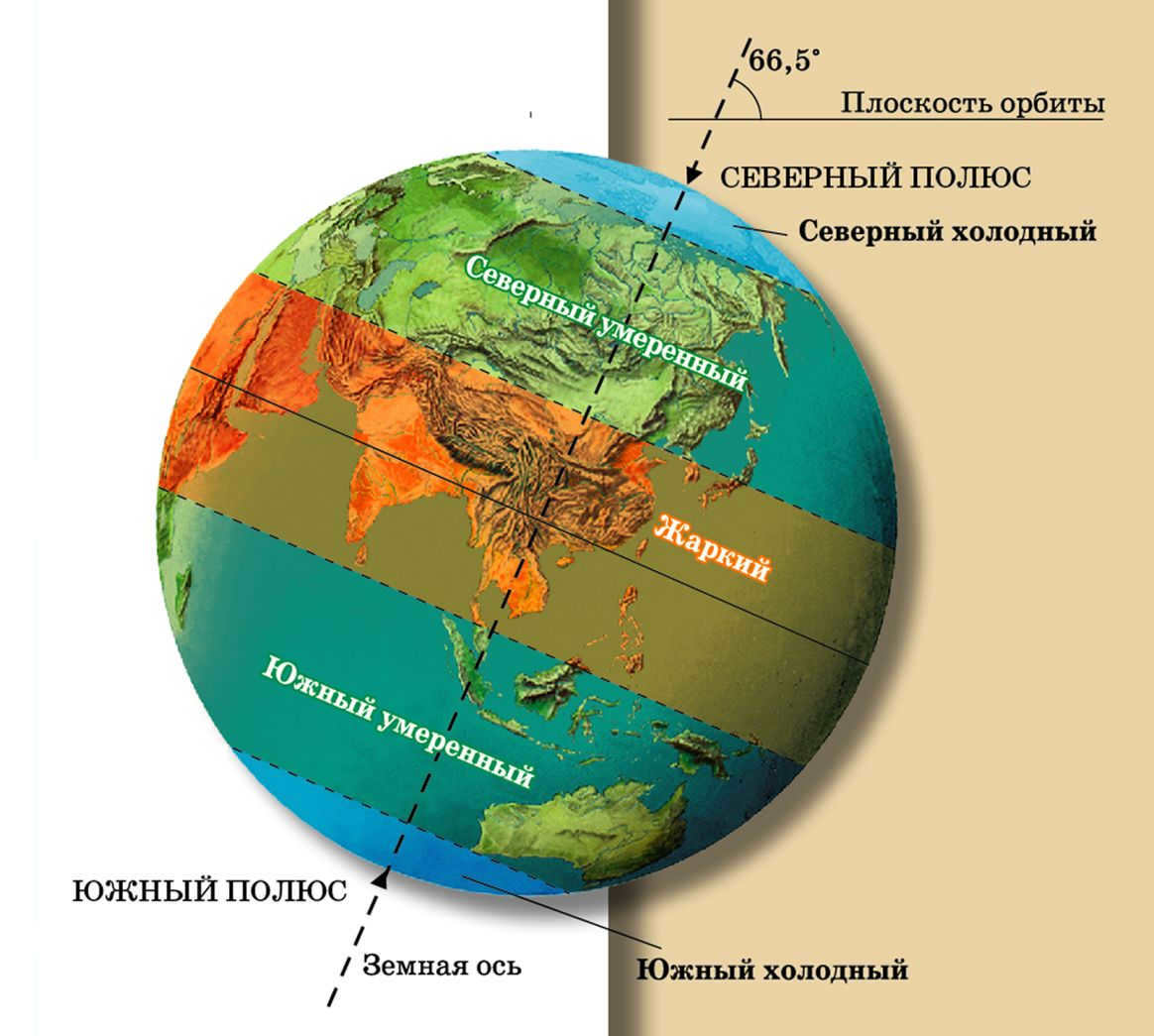
Characterizing the Illuminance belts
Situated between the tropic and the Arctic Circle within the hemisphere.
The sun is never directly overhead.
Throughout the year, the angle at which the sun’s rays hit the Earth varies significantly, resulting in distinct thermal seasons (summer, autumn, winter, spring). The temperatures experienced during summer and winter are vastly different. For instance, at a latitude of 50o
Situated within the polar circle in each hemisphere.
During winter, the Sun remains below the horizon for the entire day, creating the phenomenon known as the Polar Night. Conversely, in summer, the Sun never dips below the horizon, resulting in the Polar Day phenomenon. Even in summer, the angle at which the Sun’s rays hit the surface is quite shallow, resulting in minimal heating. As a result, summer temperatures rarely exceed +10°C. Throughout the long polar night, there is a significant cooling effect due to the absence of any heat influx.
As a homework assignment, the young fifth-graders were given a rather unique task – instead of creating artwork or poetry, they were asked to try their hand at writing prose. Their assignment involved crafting a fantastic story. However, this is an entirely separate tale that will be shared in exactly one week.

